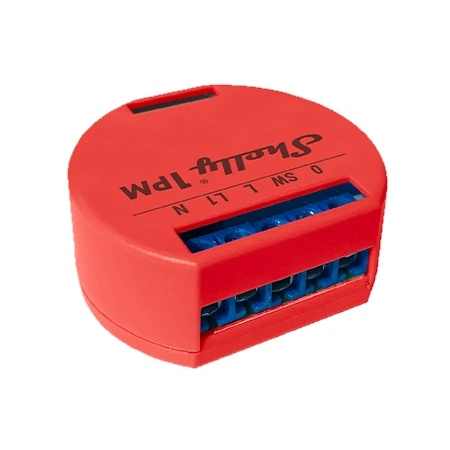
Available from:
Amazon.de
Amazon.com
Domadoo.fr
Aliexpress.com
Idealo.de
Install method:
MgOS to Tasmota
| GPIO # | Component |
|---|---|
| GPIO00 | Led1i |
| GPIO01 | None |
| GPIO02 | None |
| GPIO03 | None |
| GPIO04 | Switch1n |
| GPIO05 | BL0937 CF |
| GPIO09 | None |
| GPIO10 | None |
| GPIO12 | None |
| GPIO13 | None |
| GPIO14 | None |
| GPIO15 | Relay1 |
| GPIO16 | None |
| FLAG | Temperature |
{"NAME":"Shelly 1PM","GPIO":[56,0,0,0,82,134,0,0,0,0,0,21,0],"FLAG":2,"BASE":18}⚠️️ Special Shelly Attention ⚠️️
Do not connect AC power and the serial connection at the same time The GND connection of the Shelly has a 50% chance of being connected to the live AC wire. Connecting serial with your PC will fry your PC.
Do not connect any additional sensors to serial pins. It can at least destroy your Shelly!
Check the correct jumper position before connecting AC power to Shelly 1. If the jumper is set to 12V you will destroy your Shelly!
An ESP8266 with 2MB flash single relay device 42mm “round” in size.
Serial Flashing
Shelly 1PM comes with a partially exposed programming/debug header which can be used to flash Tasmota on the device. A USB-to-UART adapter is needed as well as a reliable 3.3V with at least 350 mA drive capability. The following diagram shows the device pinout and power source voltage selection jumper.

Calibration
Tasmota will disable serial logging after a restart as the communication between Tasmota and the Energy Monitoring chip is using the same serial interface. Make sure not to enable SerialLog as it will interfere with the Energy Monitoring functionality.
To calibrate the Energy monitoring feature connect a known load and execute the commands shown below. Assumed an AC voltage of 240V, a resistive load of 60W and a line frequency of 50Hz. With a load of 60W the current should be 60W / 240V = 0.25A.
FrequencySet 50.000
PowerSet 60.00
VoltageSet 240.0
CurrentSet 250.0
Pause a few seconds between executing the commands as the communication between Tasmota and the Energy Monitoring chip is a serial interface which can take over a second to complete.




